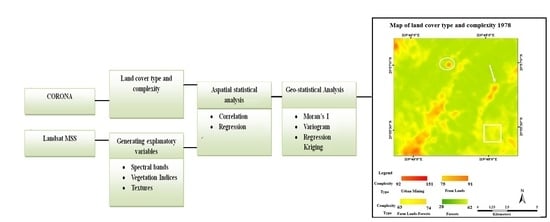Reconstructing Historical Land Cover Type and Complexity by Synergistic Use of Landsat Multispectral Scanner and CORONA
Abstract
:1. Introduction
2. Materials and Methods
2.1. Geostatistical Analysis-Regression Kriging
- (1)
- Different regression models are fitted to explore the relationship between CORONA as a surrogate of real land cover and Landsat MSS bands (this step is presented in detail in the next section).
- (2)
- Moran’s I is applied to the selected regression residuals to quantify autocorrelation. The Moran’s I statistic for spatial autocorrelation is given as [39]:where, N is the number of spatial units indexed by i and j; X is the variable of interest; is the mean of X; and Wij is an element of the matrix of spatial weights. Moran’s I varies from −1 (large negative spatial autocorrelation) to +1 (large positive spatial autocorrelation). A zero value indicates a random spatial pattern. It should be borne in mind that if the residuals exhibit no spatial autocorrelation (pure nugget effect), ordinary least squares (OLS) estimation of the regression coefficients is applied; Otherwise, if the residuals exhibit spatial autocorrelation, regressing kriging is applied [39].
- (3)
- The variogram of the residuals is used to determine the weights for spatial prediction (i.e., weights applied to observed points that are spatially auto-correlated with the site to be predicted). The empirical variogram is computed from [39]:
- (4)
- where Z(xi) is the residual value at location i, Z(xi + h) is the residual value of other locations separated from xi, by a discrete separation vector or lag h; n represents the number of pairs of observations separated by h; and is the estimated or “experimental” semivariance for all pairs of observations at lag h. Semivariances were calculated for each possible pair of observed locations, and the mean values of the semivariances were plotted against lag magnitude intervals |h| to produce the experimental variogram of the regression residuals.
- (5)
- The variogram is applied in Krige.
- (6)
- The estimated trend is added back to the Kriged estimates in Equation (1).
2.2.Building Regression Models
2.2.1. Response Variable from CORONA
2.2.2. Explanatory Variables from Landsat MSS
Vegetation Indices
Texture Measures
2.3. Collecting Training Points
2.4. Statistical Modeling
2.5. Accuracy Assessment
2.6. Comparison: Conventional Mapping Techniques
2.7.Study Region and Data
2.7.1. Study Region
2.7.2. Remote Sensing Data and Pre-Processing
2.8. Methodology
- (1)
- Response and explanatory variables: (a) response variables are provided via CORONA imagery; and (b) explanatory variables are calculated using Landsat MSS data including spectral bands, vegetation indices and corresponding texture measures.
- (2)
- Statistical analysis: (a) Pearson’s correlation coefficient is estimated between sample points of CORONA and Landsat MSS products; (b) regression models are fitted between response and explanatory variables; and (c) best regression models are selected using AIC and VIF.
- (3)
- Geostatistical analysis: (a) Moran’s I is applied to the residual values to measure spatial autocorrelation; and (b) regression residuals are subjected to kriging to generate the land cover map.
- (4)
- Accuracy assessment: A range of indices is used to evaluate the final results.
- (5)
- To provide context, we compared the performance of the proposed technique with conventional mapping techniques.
3. Results
3.1. Geometric Correction of CORONA Data
3.2. Correlation Analysis
3.3. Multiple Linear Regression Modeling
3.4. Spatial Distribution and Autocorrelation of Residuals
3.5. Land Cover Type and Complexity Prediction
3.6. Accuracy Assessment
3.6.1. Visual Assessment
3.6.2. Numerical Assessment
3.7.Comparative Analyses with other Methods
4. Discussion
4.1. Value of CORONA for Surrogacy; Advantages and Limitations
4.2. Developed Methodology
- Direct-SVH: Linking field data from an actual environment to the remotely sensed data.
- Indirect-SVH: Collecting samples from fine spatial resolution imagery (or fine radiometric resolution imagery) and linking the data to other types of remotely sensed imagery.
- Direct-Indirect-SVH: First, linking field data from an actual environment to fine spatial resolution imagery (or fine spectral resolution imagery), and correlating the evaluated samples from both resources to other types of remotely sensed imagery.
4.3. Future of CORONA in Land Cover Research
- (1)
- Spatial coverage: CORONA provides broad spatial coverage with fine spatial resolution in contrast to aerial photographs. Hence, image processing of CORONA data is very time consuming with current remote sensing software. This is one reason why the present study did not focus on a large and complex landscape. Therefore, new or improved software is needed to analyze CORONA imagery.
- (2)
- Correction (Geometric and Radiometric): Geometric distortions and anomalous brightness could restrict the accuracy of the land cover information derived from CORONA, which, in turn, might limit the effectiveness of change detection results. Consequently, future research should pay more attention to developing new mathematical algorithms (particularly in the absence of CORONA technical information) to enhance the quality and quantity of these records.
- (3)
- Between-class vs. within-class variation: While many studies have focused on the between-class land cover mapping (e.g., forest and non-forest) [7,28], few have concentrated explicitly on the importance of different texture methods (e.g., geostatistical techniques), and pattern recognition algorithms (e.g., neural networks) for quantifying within-class variation (e.g., tree types, and urban categories). In particular, these characteristics could be important for monitoring change in biodiversity.
- (4)
- Fine continuous super resolution map: Although the present study used spatial information through RK for continuous land cover mapping, we did not produce a super resolution map using this technique. Future studies may focus on historical continuous super resolution mapping [12].
- Which kinds of current remote sensing techniques might be appropriate for enhancing the quality and quantity of CORONA data?
- How can we extract historical fine details from a combination of CORONA and Landsat MSS data?
5. Conclusions
Acknowledgments
Author Contributions
Conflicts of Interest
References
- Hudak, A.T.; Wessman, C.A. Textural analysis of historical aerial photography to characterize woody plant encroachment in south african savanna. Remote Sens. Environ. 1998, 66, 317–330. [Google Scholar] [CrossRef]
- Kaim, D.; Kozak, J.; Kolecka, N.; Ziolkowska, E.; Ostafin, K.; Ostapowicz, K.; Gimmi, U.; Munteanu, C.; Radeloff, V.C. Broad scale forest cover reconstruction from historical topographic maps. Appl. Geogr. 2016, 67, 39–48. [Google Scholar] [CrossRef]
- Morgan, J.L.; Gergel, S.E.; Coops, N.C. Aerial photography: A rapidly evolving tool for ecological management. BioScience 2010, 60, 47–59. [Google Scholar] [CrossRef]
- Estes, L.D.; Okin, G.S.; Mwangi, A.G.; Shugart, H.H. Habitat selection by a rare forest antelope: A multi-scale approach combining field data and imagery from three sensors. Remote Sens. Environ. 2008, 112, 2033–2050. [Google Scholar] [CrossRef]
- Foody, G.M.; Cutler, M.E.J. Tree biodiversity in protected and logged bornean tropical rain forests and its measurement by satellite remote sensing. J. Biogeogr. 2003, 30, 1053–1066. [Google Scholar] [CrossRef]
- Hernandez-Stefanoni, J.L.; Gallardo-Cruz, J.A.; Meave, J.A.; Dupuy, J.M. Combining geostatistical models and remotely sensed data to improve tropical tree richness mapping. Ecol. Indic. 2011, 11, 1046–1056. [Google Scholar] [CrossRef]
- Song, D.X.; Huang, C.Q.; Sexton, J.O.; Channan, S.; Feng, M.; Townshend, J.R. Use of landsat and corona data for mapping forest cover change from the mid-1960s to 2000s: Case studies from the eastern united states and central brazil. ISPRS J. Photogramm. 2015, 103, 81–92. [Google Scholar] [CrossRef]
- Culbert, P.D.; Radeloff, V.C.; St-Louis, V.; Flather, C.H.; Rittenhouse, C.D.; Albright, T.P.; Pidgeon, A.M. Modeling broad-scale patterns of avian species richness across the midwestern united states with measures of satellite image texture. Remote Sens. Environ. 2012, 118, 140–150. [Google Scholar] [CrossRef]
- Duro, D.C.; Girard, J.; King, D.J.; Fahrig, L.; Mitchell, S.; Lindsay, K.; Tischendorf, L. Predicting species diversity in agricultural environments using landsat tm imagery. Remote Sens. Environ. 2014, 144, 214–225. [Google Scholar] [CrossRef]
- Rocchini, D. Effects of spatial and spectral resolution in estimating ecosystem alpha-diversity by satellite imagery. Remote Sens. Environ. 2007, 111, 423–434. [Google Scholar] [CrossRef]
- Tatem, A.J.; Lewis, H.G.; Atkinson, P.M.; Nixon, M.S. Increasing the spatial resolution of agricultural land cover maps using a hopfield neural network. Int. J. Geogr. Inf. Sci. 2003, 17, 647–672. [Google Scholar] [CrossRef]
- Atkinson, P.M. Downscaling in remote sensing. Int. J. Appl. Earth Obs. 2013, 22, 106–114. [Google Scholar] [CrossRef]
- Frizzelle, B.G.; Moody, A. Mapping continuous distributions of land cover: A comparison of maximum-likelihood estimation and artificial neural networks. Photogramm. Eng. Remote Sens. 2001, 67, 693–705. [Google Scholar]
- Atkinson, P.M. Sub-pixel target mapping from soft-classified, remotely sensed imagery. Photogramm. Eng. Remote Sens. 2005, 71, 839–846. [Google Scholar] [CrossRef]
- Weng, Q.H. Remote sensing of impervious surfaces in the urban areas: Requirements, methods, and trends. Remote Sens. Environ. 2012, 117, 34–49. [Google Scholar] [CrossRef]
- Moody, A. Using landscape spatial relationships to improve estimates of land-cover area from coarse resolution remote sensing. Remote Sens. Environ. 1998, 64, 202–220. [Google Scholar] [CrossRef]
- Palmer, M.W.; Earls, P.G.; Hoagland, B.W.; White, P.S.; Wohlgemuth, T. Quantitative tools for perfecting species lists. Environmetrics 2002, 13, 121–137. [Google Scholar] [CrossRef]
- Bellis, L.M.; Pidgeon, A.M.; Radeloff, V.C.; St-Louis, V.; Navarro, J.L.; Martella, M.B. Modeling habitat suitability for greater rheas based on satellite image texture. Ecol. Appl. 2008, 18, 1956–1966. [Google Scholar] [CrossRef] [PubMed]
- Hernandez-Stefanoni, J.L.; Gallardo-Cruz, J.A.; Meave, J.A.; Rocchini, D.; Bello-Pineda, J.; Lopez-Martinez, J.O. Modeling alpha- and beta-diversity in a tropical forest from remotely sensed and spatial data. Int. J. Appl. Earth Obs. 2012, 19, 359–368. [Google Scholar] [CrossRef]
- Berberoğlu, S.; Akin, A.; Atkinson, P.M.; Curran, P.J. Utilizing image texture to detect land-cover change in mediterranean coastal wetlands. Int. J. Remote Sens. 2010, 31, 2793–2815. [Google Scholar] [CrossRef]
- Lu, D.; Batistella, M. Exploring tm image texture and its relationships with biomass estimation in rondônia, brazilian amazon. Acta Amazonica 2005, 35, 249–257. [Google Scholar] [CrossRef]
- St-Louis, V.; Pidgeon, A.M.; Clayton, M.K.; Locke, B.A.; Bash, D.; Radeloff, V.C. Satellite image texture and a vegetation index predict avian biodiversity in the chihuahuan desert of new mexico. Ecography 2009, 32, 468–480. [Google Scholar] [CrossRef]
- Hengl, T.; Heuvelink, G.B.M.; Rossiter, D.G. About regression-kriging: From equations to case studies. Comput. Geosci. 2007, 33, 1301–1315. [Google Scholar] [CrossRef]
- Meng, Q.M.; Liu, Z.J.; Borders, B.E. Assessment of regression kriging for spatial interpolation - comparisons of seven gis interpolation methods. Cartogr. Geogr. Inf. Sci. 2013, 40, 28–39. [Google Scholar] [CrossRef]
- Munteanu, C.; Kuemmerle, T.; Keuler, N.S.; Muller, D.; Balazs, P.; Dobosz, M.; Griffiths, P.; Halada, L.; Kaim, D.; Kiraly, G.; et al. Legacies of 19th century land use shape contemporary forest cover. Glob. Environ. Chang. 2015, 34, 83–94. [Google Scholar] [CrossRef]
- Jiao, Q.J.; Zhang, B.; Liu, L.Y. The feasibility of landscape pattern analysis within the alpine steppe of the yellow river source based on historical corona panchromatic imagery. In Proceedings of the Earth Resources and Environmental Remote Sensing/Gis Applications III, Edinburgh, UK, 24–26 September 2012; Volume 8538. [Google Scholar]
- Zhang, X.P.; Pan, D.L.; Chen, J.Y.; Zhan, Y.Z.; Mao, Z.H. Using long time series of landsat data to monitor impervious surface dynamics: A case study in the zhoushan islands. J. Appl. Remote Sens. 2013, 7. [Google Scholar] [CrossRef]
- Hamandawana, H.; Eckardt, F.; Ringrose, S. The use of step-wise density slicing in classifying high-resolution panchromatic photographs. Int. J. Remote Sens. 2006, 27, 4923–4942. [Google Scholar] [CrossRef]
- Li, L.X.; Lambin, E.F.; Wu, W.; Servais, M. Land-cover changes in tarim basin (1964–2000): Application of post-classification change detection technique. In Ecosystems Dynamics, Ecosystem-Society Interactions, and Remote Sensing Applications for Semi-Arid and Arid Land; Pan, X., Gao, W., Glantz, M.H., Honda, Y., Eds.; SPIE: Bellingham, CD, USA, 2003. [Google Scholar]
- Musaoglu, N.; Bektas, F.; Saroglu, E.; Kaya, S.; Goksel, C. Use of CORONA, Landsat TM, SPOT 5 images to assess 40 years of land use/cover changes in cavusbasi. New Strateg. Eur. Remote Sens. 2005, 161–165. [Google Scholar]
- Cetin, M. A satellite based assessment of the impact of urban expansion around a lagoon. Int. J. Environ. Sci. Technol. 2009, 6, 579–590. [Google Scholar] [CrossRef]
- Andersen, G.L. How to detect desert trees using CORONA images: Discovering historical ecological data. J. Arid Environ. 2006, 65, 491–511. [Google Scholar] [CrossRef]
- Chen, J.Y.; Zhan, Y.Z.; Mao, Z.H. Land-cover change and its time-series reconstructed using remotely sensed imageries in the zhoushan islands. In Proceedings of the SPIE, Remote Sensing for Environmental Monitoring, GIS Applications, and Geology IX, Berlin, Germany, 31 August 2009; Volume 7478. [Google Scholar]
- Dittrich, A.; Buerkert, A.; Brinkmann, K. Assessment of land use and land cover changes during the last 50 years in oases and surrounding rangelands of xinjiang, nw china. J. Agric. Rural Dev. Trop. 2010, 111, 129–142. [Google Scholar]
- Ruelland, D.; Tribotte, A.; Puech, C.; Dieulin, C. Comparison of methods for lucc monitoring over 50 years from aerial photographs and satellite images in a sahelian catchment. Int. J. Remote Sens. 2011, 32, 1747–1777. [Google Scholar] [CrossRef]
- Rigina, O. Detection of boreal forest decline with high-resolution panchromatic satellite imagery. Int. J. Remote Sens. 2003, 24, 1895–1912. [Google Scholar] [CrossRef]
- Meng, Q.M.; Cieszewski, C.; Madden, M. Large area forest inventory using landsat etm plus: A geostatistical approach. ISPRS J. Photogramm. 2009, 64, 27–36. [Google Scholar] [CrossRef]
- Jensen, J.R. Introductory Digital Image Processing: A Remote Sensing Perspective, 3rd ed.; Prentice Hall: Upper Saddle River, NJ, USA, 2005; p. xv. 526p. [Google Scholar]
- Teng, H.F.; Shi, Z.; Ma, Z.Q.; Li, Y. Estimating spatially downscaled rainfall by regression kriging using trmm precipitation and elevation in zhejiang province, southeast china. Int. J. Remote Sens. 2014, 35, 7775–7794. [Google Scholar] [CrossRef]
- Webster, R.; Oliver, M.A. Geostatistics for Environmental Scientists; John Wiley & Sons: Chichester, UK; New York, NY, USA, 2007; p. xi. 271p. [Google Scholar]
- Pebesma, E.J. Multivariable geostatistics in s: The gstat package. Comput. Geosci. 2004, 30, 683–691. [Google Scholar] [CrossRef]
- Wood, E.M.; Pidgeon, A.M.; Radeloff, V.C.; Keuler, N.S. Image texture as a remotely sensed measure of vegetation structure. Remote Sens. Environ. 2012, 121, 516–526. [Google Scholar] [CrossRef]
- Estes, L.D.; Reillo, P.R.; Mwangi, A.G.; Okin, G.S.; Shugart, H.H. Remote sensing of structural complexity indices for habitat and species distribution modeling. Remote Sens. Environ. 2010, 114, 792–804. [Google Scholar] [CrossRef]
- Yang, J.; Weisberg, P.J.; Bristow, N.A. Landsat remote sensing approaches for monitoring long-term tree cover dynamics in semi-arid woodlands: Comparison of vegetation indices and spectral mixture analysis. Remote Sens. Environ. 2012, 119, 62–71. [Google Scholar] [CrossRef]
- Altmaier, A.; Kany, C. Digital surface model generation from corona satellite images. ISPRS J. Photogramm. 2002, 56, 221–235. [Google Scholar] [CrossRef]
- Casana, J.; Cothren, J. Stereo analysis, dem extraction and orthorectification of corona satellite imagery: Archaeological applications from the near east. Antiquity 2008, 82, 732–749. [Google Scholar] [CrossRef]
- Peebles, C. The Corona Project: America’s First Spy Satellites; Naval Institute Press: Annapolis, MD, USA, 1997; p. xii. 351p. [Google Scholar]
- Sohn, H.G.; Kim, G.H.; Yom, J.H. Mathematical modelling of historical reconnaissance CORONA kh-4b imagery. Photogramm. Rec. 2004, 19, 51–65. [Google Scholar] [CrossRef]
- Tappan, G.G.; Hadj, A.; Wood, E.C.; Lietzow, R.W. Use of Argon, CORONA, and Landsat imagery to assess 30 years of land resource changes in west-central senegal. Photogramm. Eng. Remote Sens. 2000, 66, 727–735. [Google Scholar]
- Zhou, G.Q.; Jezek, K.; Allen, T.R. Greenland ice sheet mapping using 1960s disp imagery. Int. Geosci. Remote Sens. 2003, 3632–3634. [Google Scholar]
- Galiatsatos, N. Assessment of the CORONA Series of Satellite Imagery for Landscape Archaeology: A Case Study from the Orontes Valley, Syria; Durham University: Durham, UK, 2004. [Google Scholar]
- Hamandawana, H.; Eckardt, F.; Ringrose, S. Proposed methodology for georeferencing and mosaicking CORONA photographs. Int. J. Remote Sens. 2007, 28, 5–22. [Google Scholar] [CrossRef]
- Singh, M.; Malhi, Y.; Bhagwat, S. Evaluating land use and aboveground biomass dynamics in an oil palm-dominated landscape in borneo using optical remote sensing. J. Appl. Remote Sens. 2014, 8. [Google Scholar] [CrossRef]
- Rossi, R.E.; Dungan, J.L.; Beck, L.R. Kriging in the shadows—Geostatistical interpolation for remote-sensing. Remote Sens. Environ. 1994, 49, 32–40. [Google Scholar] [CrossRef]
- Zhang, X.Y.; Jiang, H.; Zhou, G.M.; Xiao, Z.Y.; Zhang, Z. Geostatistical interpolation of missing data and downscaling of spatial resolution for remotely sensed atmospheric methane column concentrations. Int. J. Remote Sens. 2012, 33, 120–134. [Google Scholar] [CrossRef]
- Tuttle, E.M.; Jensen, R.R.; Formica, V.A.; Gonser, R.A. Using remote sensing image texture to study habitat use patterns: A case study using the polymorphic white-throated sparrow (zonotrichia albicollis). Glob. Ecol. Biogeogr. 2006, 15, 349–357. [Google Scholar] [CrossRef]
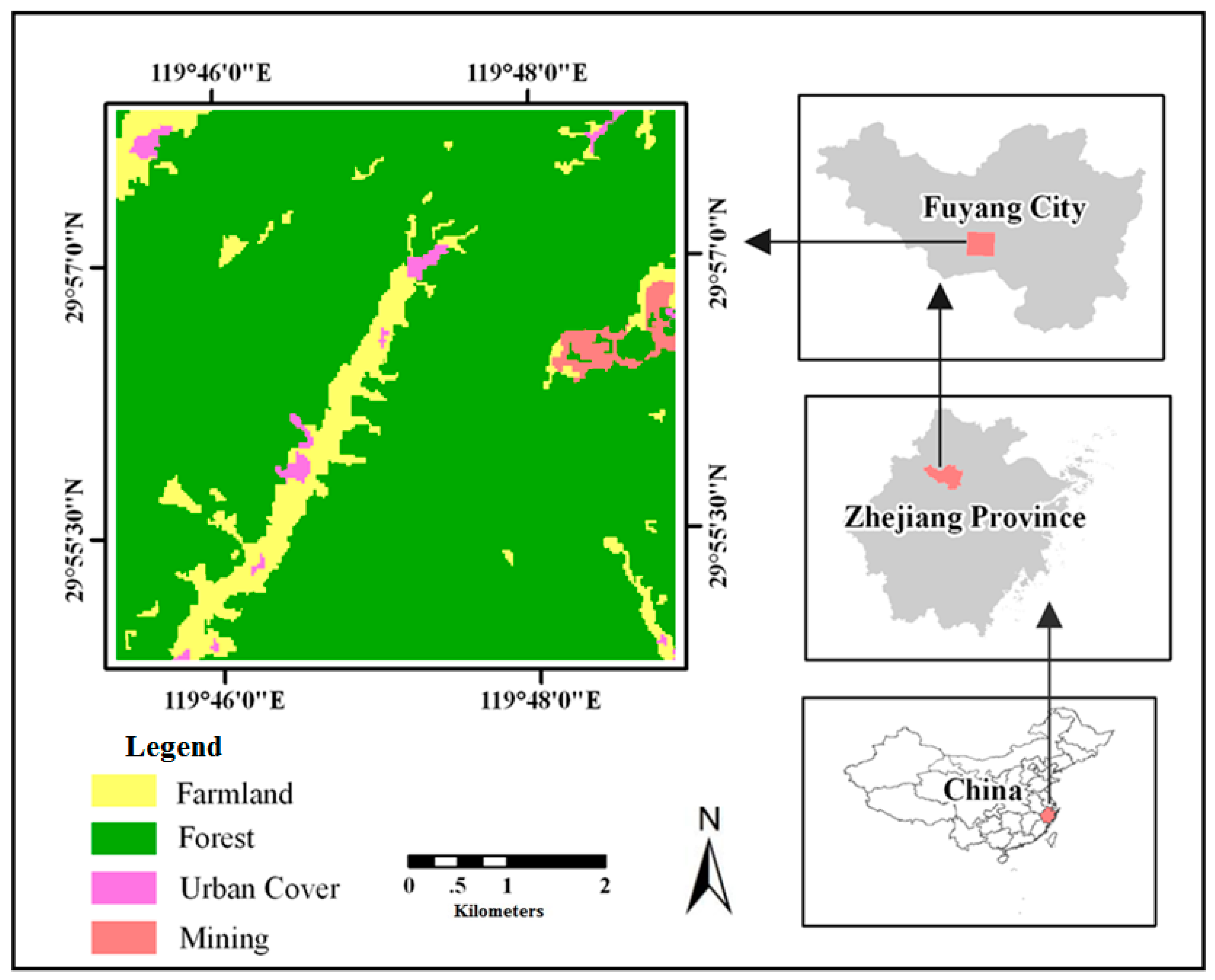
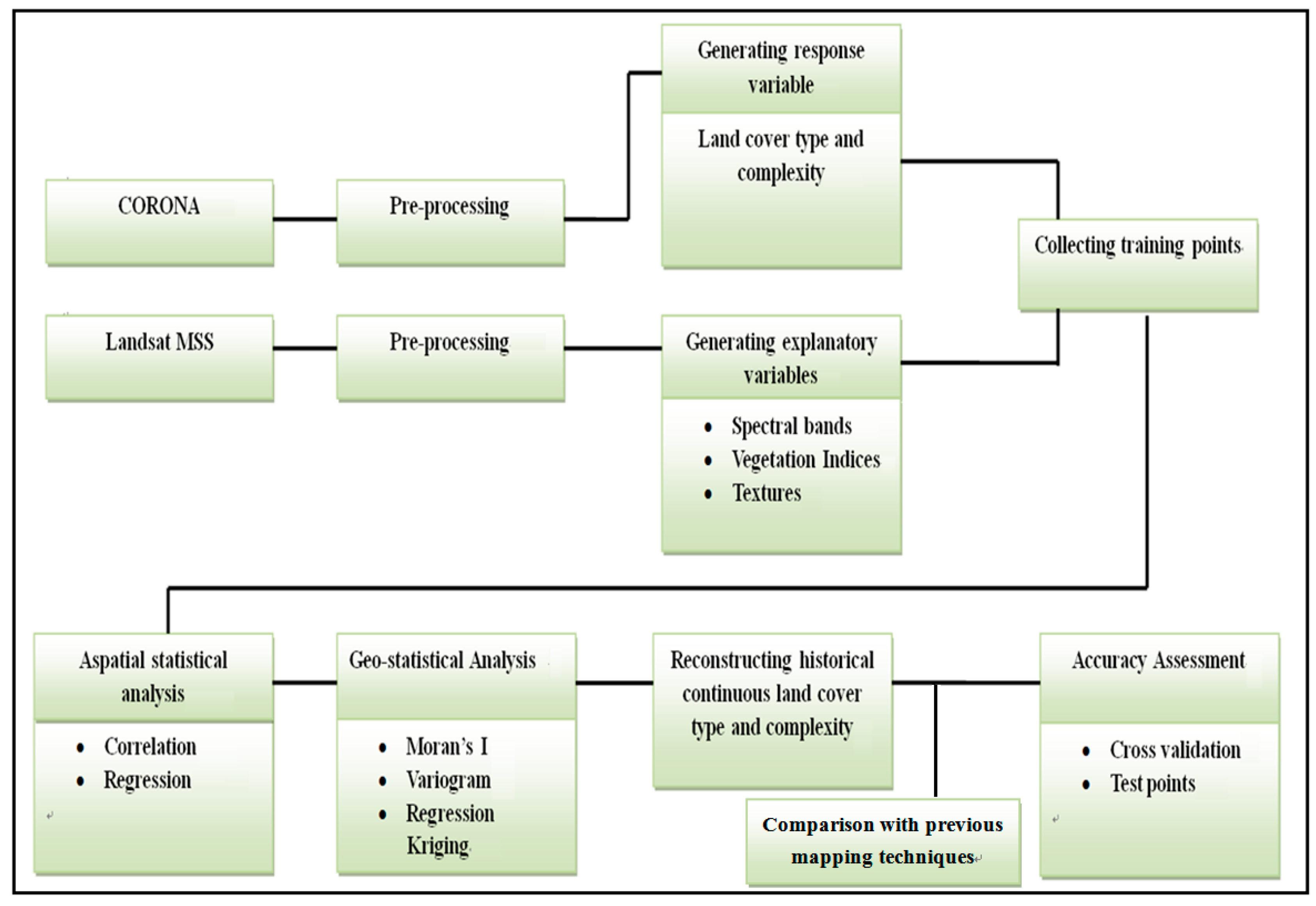
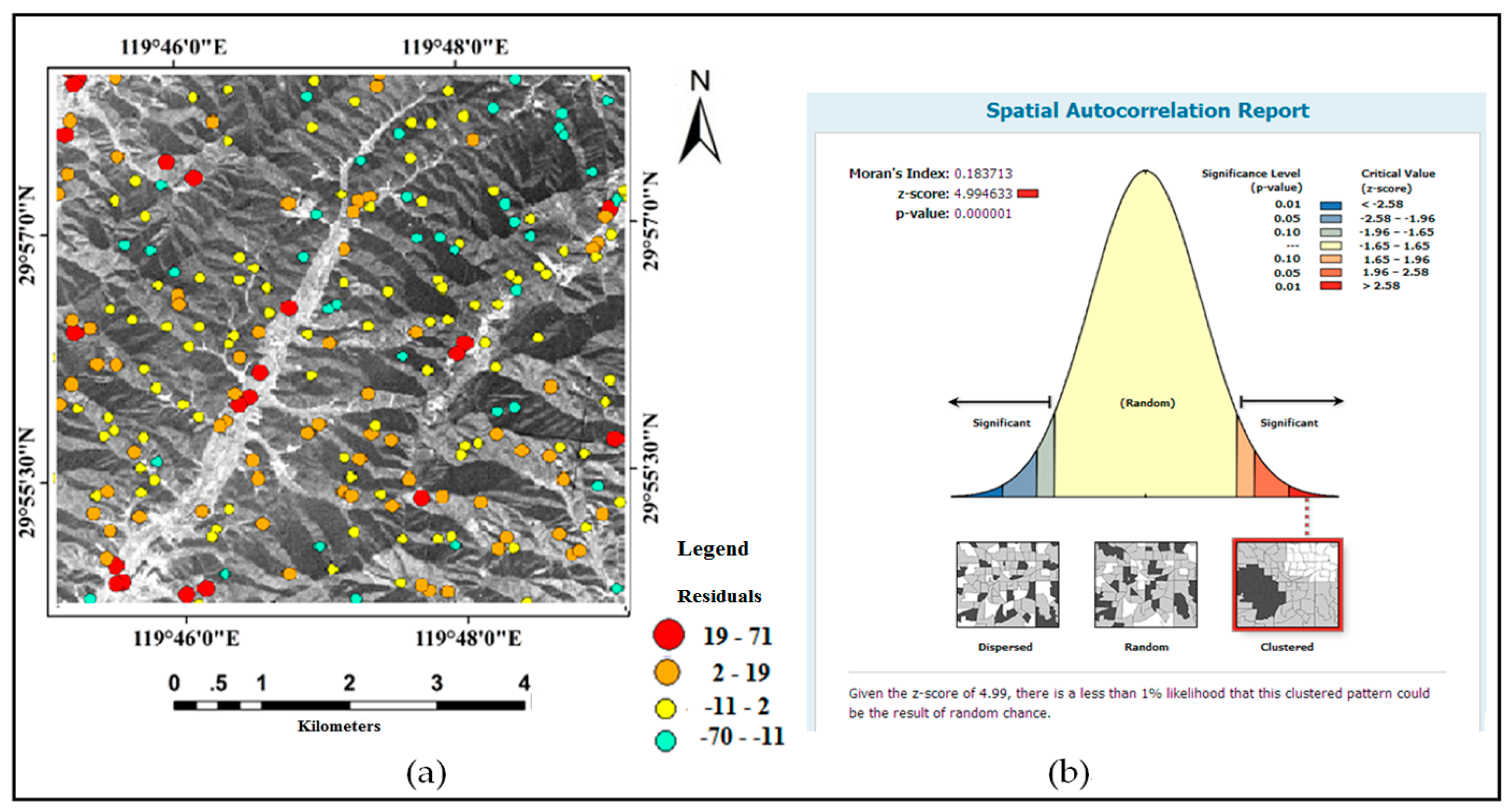
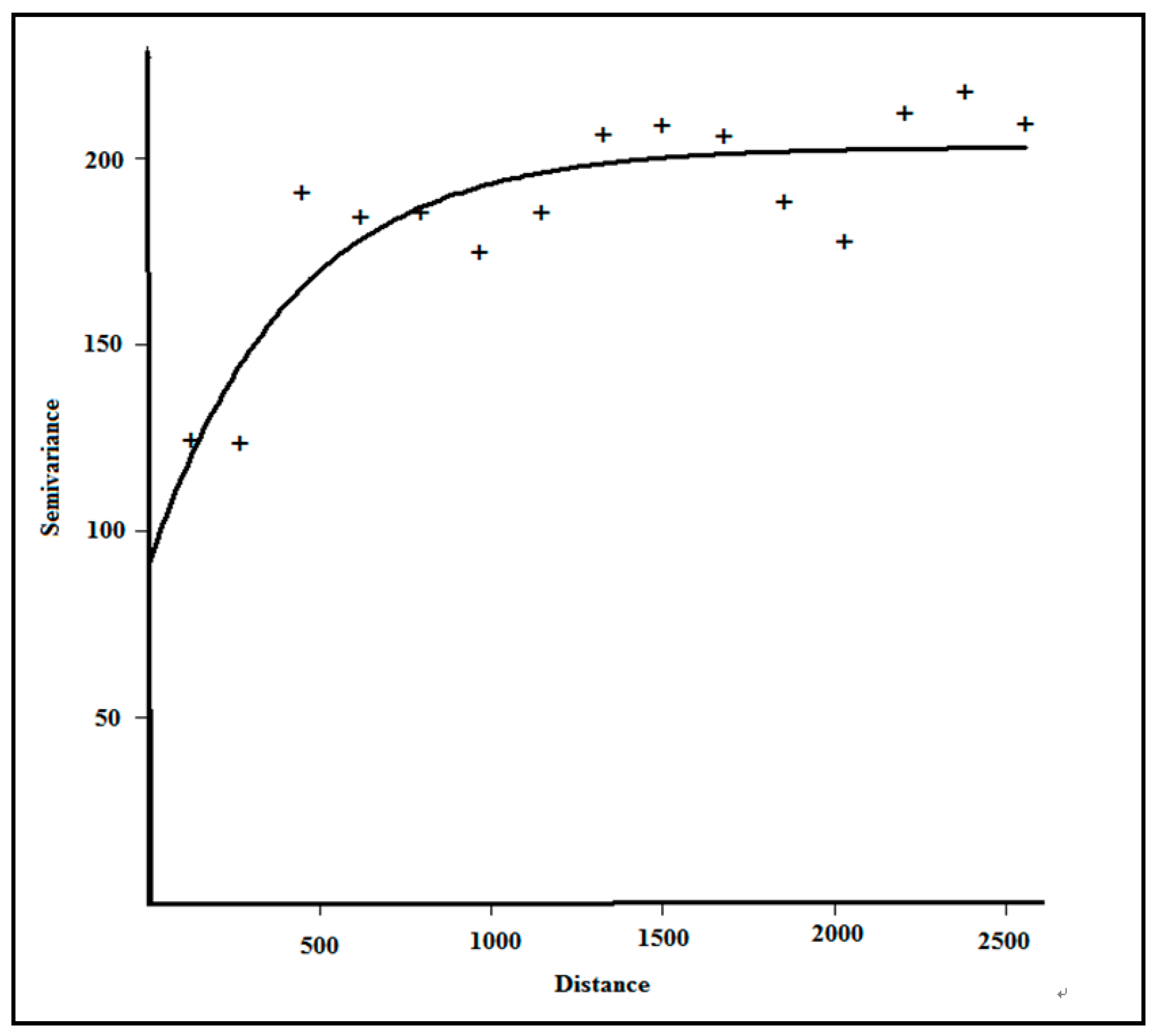
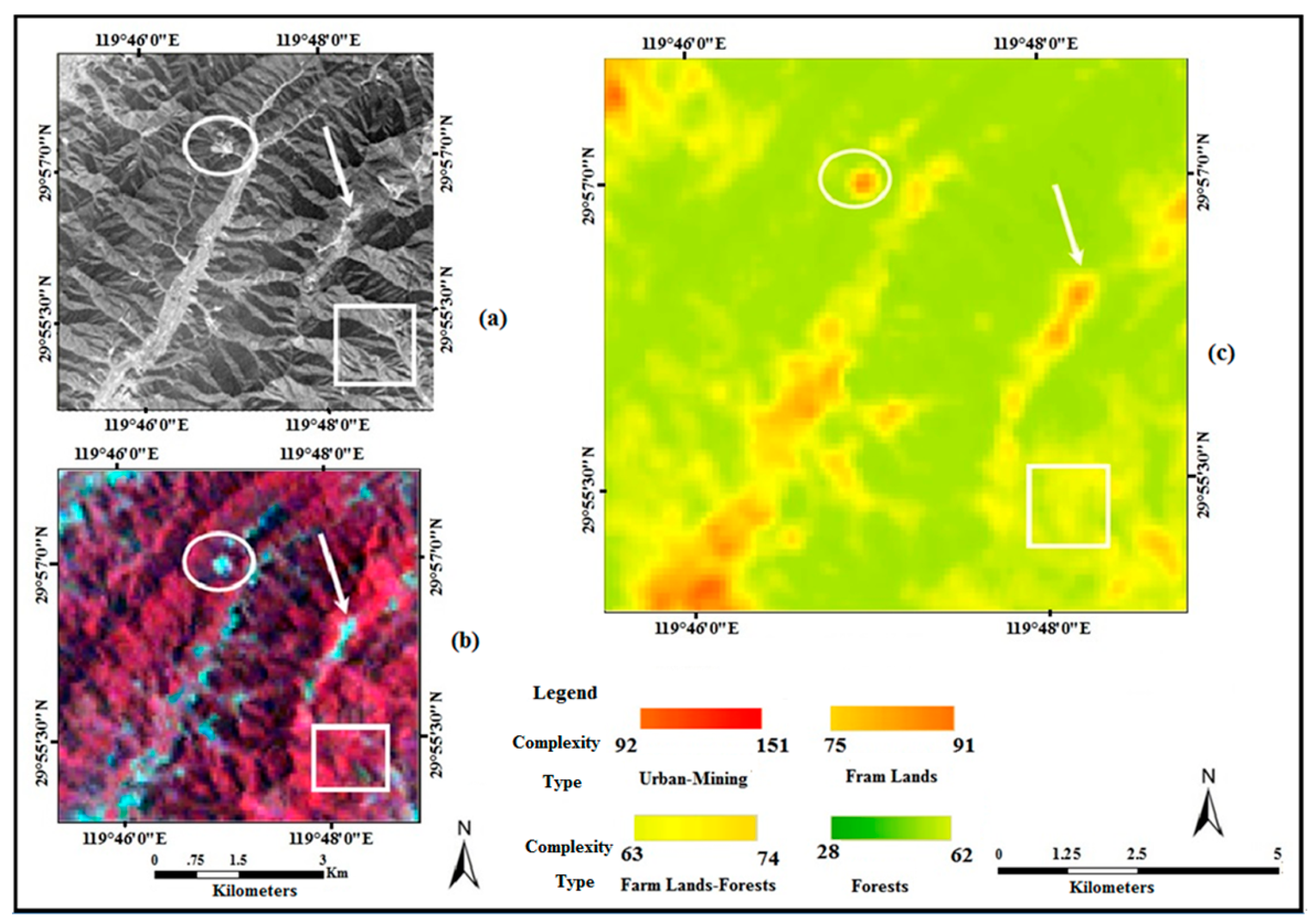
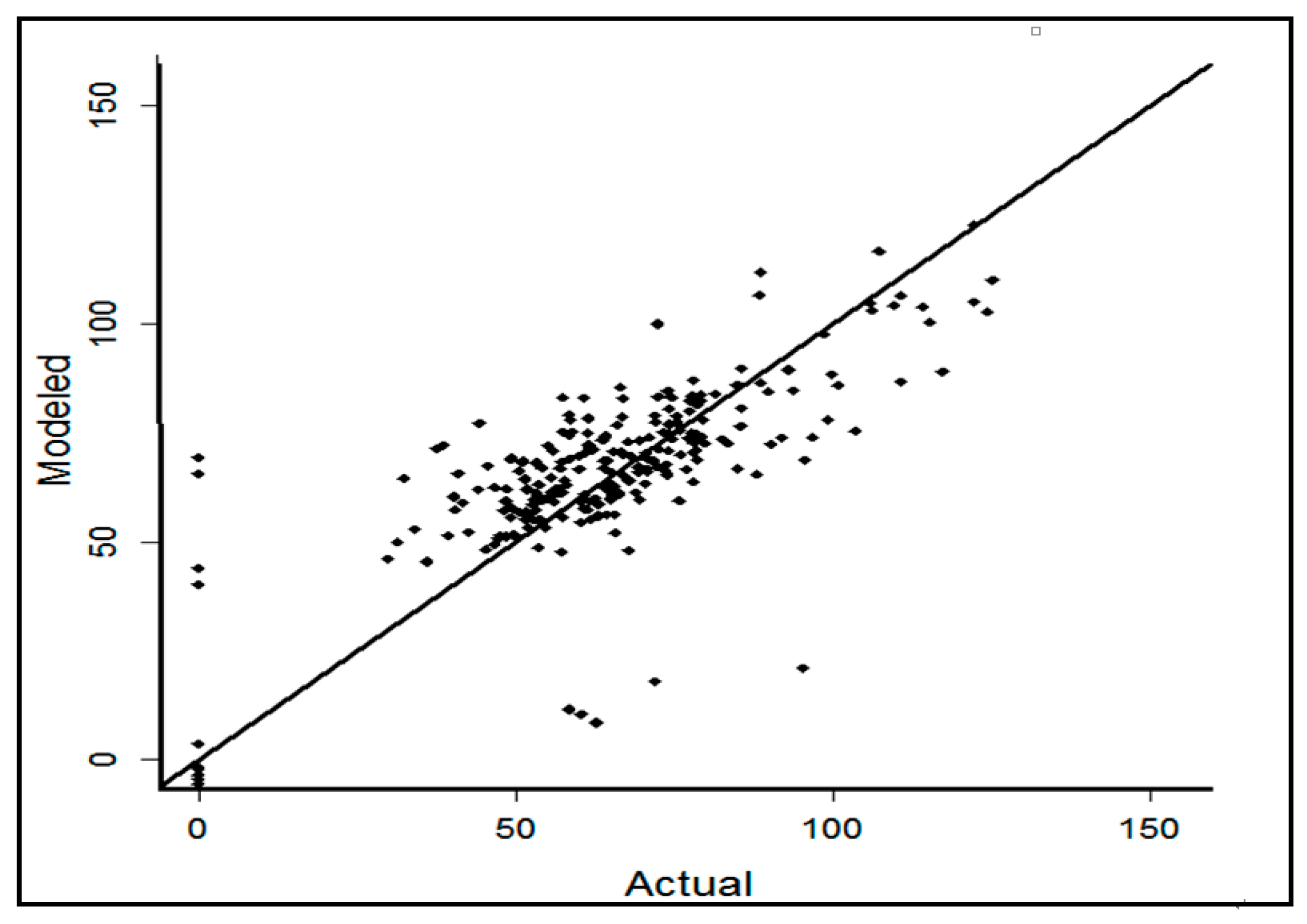
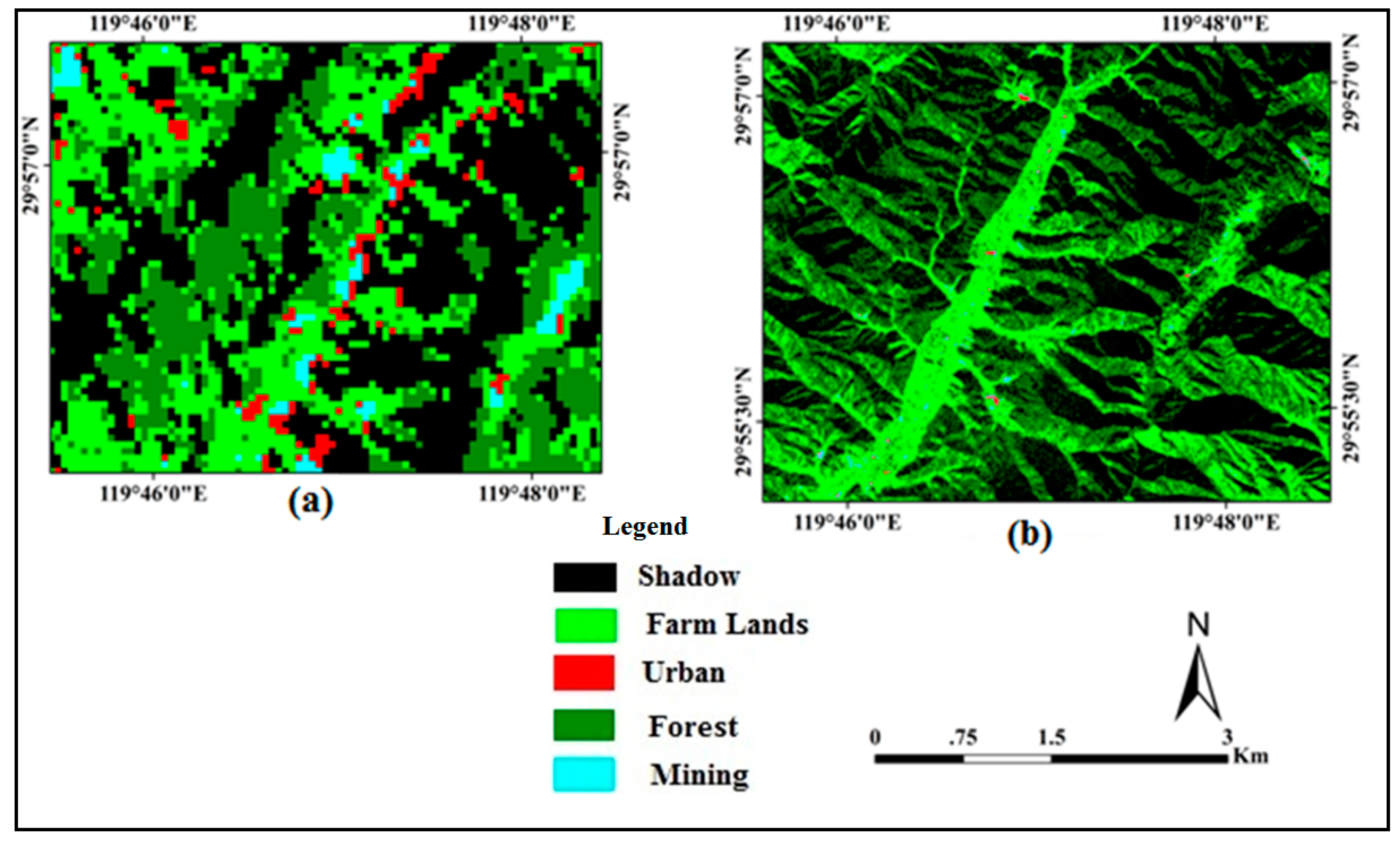
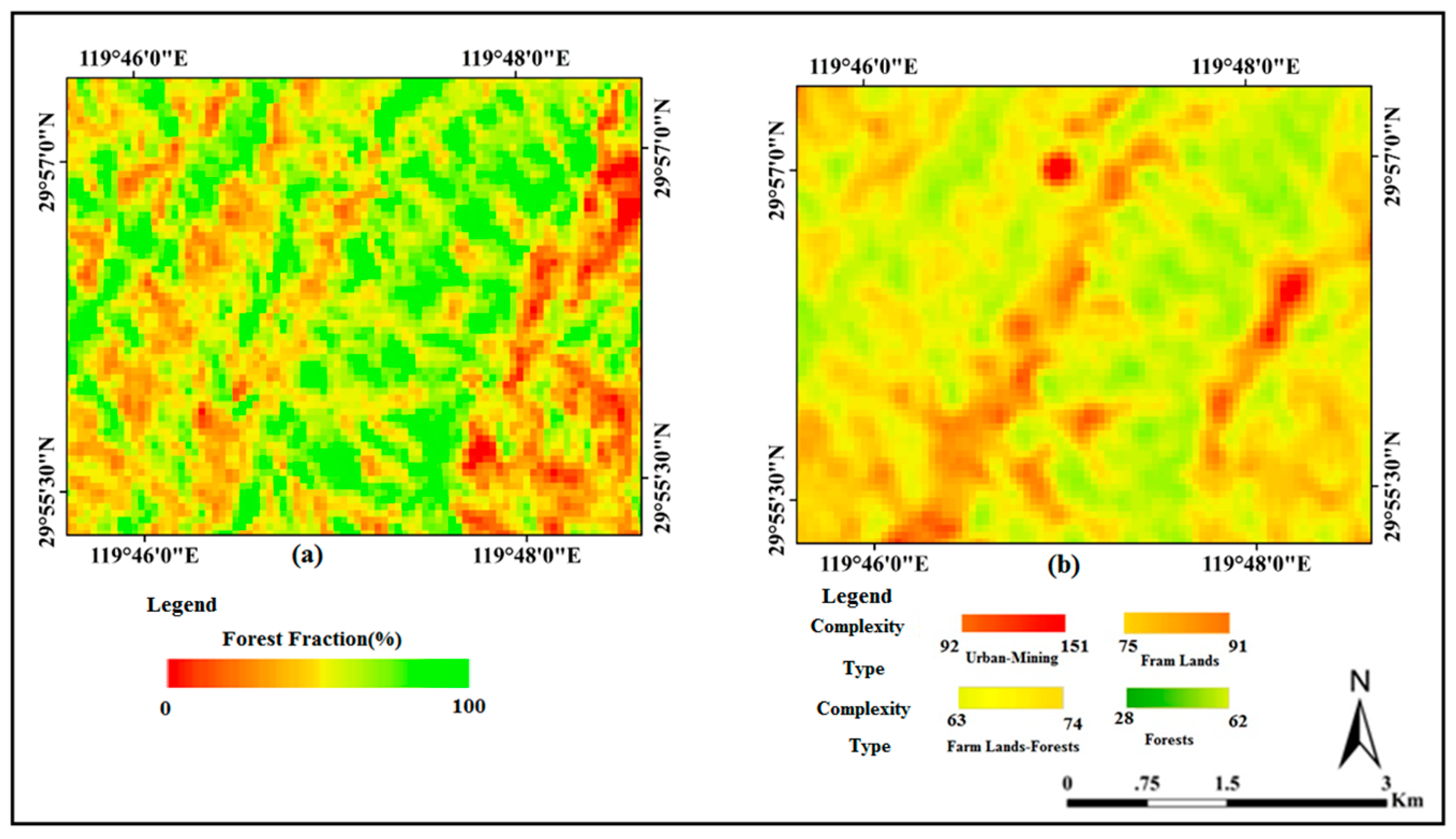
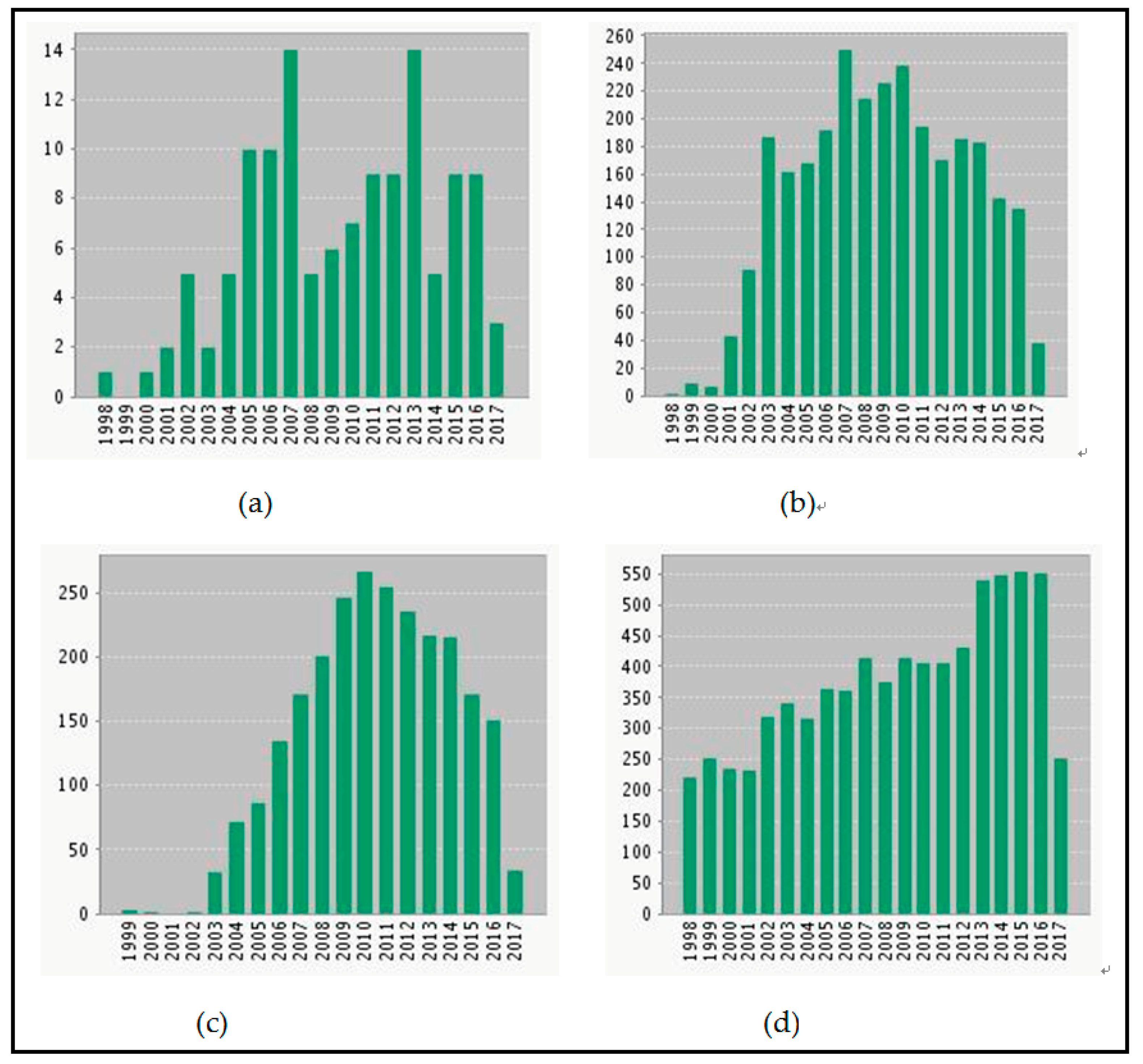

| Categories of Study | Mapping Approach | Objective | Reference |
|---|---|---|---|
| Change detection | Hard classification | Impervious surface mapping | [27] |
| Change detection | On screen interpretation | Mapping pattern and dynamic of land cover | [35] |
| Land use/cover change | Density Slicing technique | Mapping Forest | [30] |
| Change detection | Visual interpretation | Change of range land | [34] |
| Classification | Step-wise density slicing | Mapping land cover | [28] |
| Land cover mapping | Segmentation | Landscape pattern features | [26] |
| and cover change | Visual interpretation | Change detection | [33] |
| Land cover change | ISODATA | Change detection | [29] |
| Points | X Residual (m) | Y Residual (m) | RMS Error (m) |
|---|---|---|---|
| 1 | 0.5117 | 1.0687 | 1.189 |
| 2 | 7.6081 | 1.111 | 7.6888 |
| 3 | 4.8855 | −1.9936 | 5.2766 |
| 4 | −3.8865 | 1.0848 | 4.0351 |
| 5 | 5.0202 | 1.1157 | 5.1427 |
| 6 | 3.0993 | 2.3951 | 3.9169 |
| 7 | 7.6081 | 1.111 | 7.6888 |
| 8 | 3.976 | 1.5839 | 4.2798 |
| 9 | 1.6541 | 1.6648 | 2.3468 |
| 10 | 3.2691 | 5.0614 | 6.0254 |
| 11 | 2.9597 | 1.7869 | 3.4772 |
| 12 | 1.2547 | 0.7627 | 1.4684 |
| 13 | 5.2505 | 3.5758 | 6.3525 |
| 14 | −4.0958 | 2.1237 | 4.6136 |
| Bands | Correlation with LC | Bands | Correlation with LC | Bands | Correlation with LC |
|---|---|---|---|---|---|
| Near Infrared | Visible | Tasseled Cap | |||
| 1SOMNIR1 | 0.65 | SOMGreen | 0.75 | SOMTCB | 0.68 |
| SOMNIR2 | 0.63 | SOMRed | 0.69 | FOMTB | 0.64 |
| 2SOENIR2 | 0.61 | FOMRed | 0.66 | SOETCB | 0.63 |
| SOENIR1 | 0.61 | FOMGreen | 0.65 | SOEGBD | 0.63 |
| 3FOMBNIR1 | 0.61 | SOERed | 0.61 | SOETGe | 0.63 |
| SOEYe | 0.62 | ||||
| Near Infrared Indices | Visible Indices | ||||
| SOENDVI | 0.63 | SOMNVI | 0.74 | ||
| SOES7 | 0.62 | SOMS5 | 0.73 | ||
| FOMS5 | 0.65 | ||||
| SOENVI | 0.63 | ||||
| SOES5 | 0.61 |
| Equation 1 | r2 | AIC | VIF |
|---|---|---|---|
| LC ~ FOMG + SMTCB + SOMNVI + SOENIR2 | 0.61 | 1961.6 | 2.3 2.6 2.9 2.2 |
| LC ~ SOMS5 + FOMG + SOMNIR1 | 0.61 | 1964.4 | 2.1 2.0 2.0 |
| LC ~ SOMG + FOMS5 + SOMNIR1 | 0.60 | 1966.8 | 3.3 1.9 2.6 |
| LC ~ SOMNIR2 + SOES5 + FOMTCBr | 0.49 | 2027.1 | 3.8 2.5 2.5 |
| LC ~ FOMNIR1 + SOES7 + FOMS5 | 0.49 | 2023.5 | 4.0 1.8 4.3 |
| LC ~ SOENDVI + FOMTBS + SOMTCBr + SOMNVI | 0.61 | 1963.6 | 2.2 2.8 3.7 2.9 |
| LC ~ FOMR + SOMNIR2 + SOENVI | 0.56 | 1990.2 | 1.5 2.7 2.7 |
| LC ~ FOMS5 + SOETCGr + SOMNIR1 | 0.55 | 1998.0 | 1.86 2.5 2.1 |
| RMSE | BE | r2 (%) | |
|---|---|---|---|
| Cross–validation RK | 14.23 | −0.23 | 68.28 |
| Unseen sample points RK | 15.90 | 2.02 | 51.39 |
© 2017 by the authors. Licensee MDPI, Basel, Switzerland. This article is an open access article distributed under the terms and conditions of the Creative Commons Attribution (CC BY) license (http://creativecommons.org/licenses/by/4.0/).
Share and Cite
Shahtahmassebi, A.R.; Lin, Y.; Lin, L.; Atkinson, P.M.; Moore, N.; Wang, K.; He, S.; Huang, L.; Wu, J.; Shen, Z.; et al. Reconstructing Historical Land Cover Type and Complexity by Synergistic Use of Landsat Multispectral Scanner and CORONA. Remote Sens. 2017, 9, 682. https://doi.org/10.3390/rs9070682
Shahtahmassebi AR, Lin Y, Lin L, Atkinson PM, Moore N, Wang K, He S, Huang L, Wu J, Shen Z, et al. Reconstructing Historical Land Cover Type and Complexity by Synergistic Use of Landsat Multispectral Scanner and CORONA. Remote Sensing. 2017; 9(7):682. https://doi.org/10.3390/rs9070682
Chicago/Turabian StyleShahtahmassebi, Amir Reza, Yue Lin, Lin Lin, Peter M. Atkinson, Nathan Moore, Ke Wang, Shan He, Lingyan Huang, Jiexia Wu, Zhangquan Shen, and et al. 2017. "Reconstructing Historical Land Cover Type and Complexity by Synergistic Use of Landsat Multispectral Scanner and CORONA" Remote Sensing 9, no. 7: 682. https://doi.org/10.3390/rs9070682





